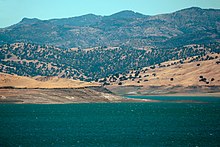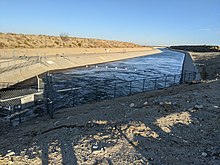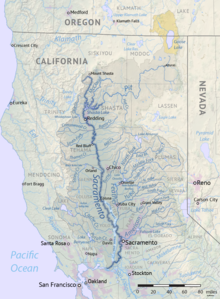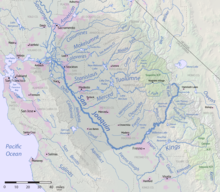California Aqueduct
California Aqueduct | |
|---|---|
| Official name | Governor Edmund G. Brown California Aqueduct |
| Maintained by | California Department of Water Resources |
| Characteristics | |
| Total length | Total: 444 mi (715 km) Main: 304 mi (489 km) East Branch: 140 mi (230 km) |
| Width | 110 ft (34 m) max. |
| Height | 40 ft (12 m) max. |
| Capacity | 13,100 cu ft/s (370 m3/s) max |
| History | |
| Construction start | 1963 |
| Opened |
|
| Location | |
 | |
| References | |
| [3] | |
The Governor Edmund G. Brown California Aqueduct is a system of canals, tunnels, and pipelines that conveys water collected from the
The aqueduct begins at the
The
The Castaic Power Plant, while similar and which is owned and operated by the Los Angeles Department of Water and Power, is located on the northern end of Castaic Lake, while Castaic Dam is located at the southern end.
The aqueduct system

The aqueduct serves 35 million people and 5.7 million acres of farmland,
Water flows through the aqueduct in a series of abrupt rises and gradual falls. The water flows down a long segment, built at a slight grade, and arrives at a pumping station powered by
A typical section has a concrete-lined channel 40 feet (12 m) at the base and an average water depth of about 30 ft (9.1 m). The widest section of the aqueduct is 110 feet (34 m) and the deepest is 32 feet (9.8 m). Channel capacity is 13,100 cubic feet per second (370 m3/s) and the largest pumping plant capacity at Dos Amigos is 15,450 cubic feet per second (437 m3/s).
A 2021 study published in
Branches
From its beginning until its first branch, the aqueduct passes through parts of Contra Costa, Alameda, San Joaquin, Stanislaus, Merced, Fresno, and Kings counties. The aqueduct then divides into three branches: the Coastal Branch in the Central Valley, and the East and West Branches after passing over the Tehachapi Mountains.
Coastal Branch
The Coastal Branch splits from the main line 11.3 mi (18.2 km) south-southeast of
Coastal Branch facilities include:[11]
- Las Perillas Pumping Plant
- Badger Hill Pumping Plant
- Devil's Den Pumping Plant
- Bluestone Pumping Plant
- Polonio Pass Pumping Plant
- Polonio Pass Water Treatment Plant
- Cuesta Tunnel[12]
- Santa Ynez Pumping Facility[12]
East Branch

The aqueduct splits off into the East Branch and West Branch in extreme southern Kern County, north of the Los Angeles County line. The East Branch supplies Lake Palmdale and terminates at Lake Perris, in the area of the San Gorgonio Pass. It passes through parts of Kern, Los Angeles, San Bernardino, and Riverside counties.
East Branch facilities include:[11]
- Tehachapi East Afterbay
- Alamo Power Plant
- Pearblossom Pumping Plant
- Mojave Siphon
- Mojave Siphon Power Plant
- Cedar Springs Dam
- Silverwood Lake
- San Bernardino Intake Structure
- San Bernardino Tunnel
- Devil Canyon Power Plant
- Devil Canyon Afterbay 1 and Afterbay 2
- Greenspot Pump Station (Backup)
- Citrus Reservoir
- Citrus Pump Station
- Crafton Hills Reservoir
- Crafton Hills Pump Station
- Cherry Valley Pump Station
- Perris Lake and Dam
West Branch
The West Branch continues to head towards its terminus at Pyramid Lake and Castaic Lake in the Angeles National Forest to supply the western Los Angeles basin. It passes through parts of Kern and Los Angeles counties.
West Branch facilities include[11]
- Oso Pumping Plant
- Peace Valley Pipeline
- Warne Powerplant
- Angeles Tunnel
- Castaic Power Plant
Bikeway
When it was open, the California Aqueduct Bikeway was the longest of the paved paths in the
Pumping stations
- Phase I, canal
- Las Perillas Pumping Plant 35°50′35″N 119°54′33″W / 35.843143°N 119.909055°W, Kings County
- Badger Hill Pumping Plant 35°50′05″N 119°56′34″W / 35.834680°N 119.942658°W, Kings County
- Phase II, pipeline and tunnel
- Devil's Den Pumping Plant 35°42′43″N 120°00′39″W / 35.711935°N 120.010958°W, Kern County
- Bluestone Pumping Plant 35°42′29″N 120°05′04″W / 35.707946°N 120.084429°W, Kern County
- Polonio Pass Pumping Plant 35°43′52″N 120°12′28″W / 35.731046°N 120.207682°W, San Luis Obispo County
Hydrography
Two major river systems drain and define the two parts of the Central Valley. Their impact on the California Aqueduct is both direct and indirect. The Sacramento River, along with its tributaries the Feather River and American River, flows southwards through the Sacramento Valley for about 447 miles (719 km).[13] In the San Joaquin Valley, the San Joaquin River flows roughly northwest for 365 miles (587 km), picking up tributaries such as the Merced River, Tuolumne River, Stanislaus River and Mokelumne River.[14]
In the south part of the San Joaquin Valley, the
The rivers of the Central Valley converge in the
The Sacramento River carries far more water than the San Joaquin, with an estimated 22 million acre-feet (27 km3) of virgin annual runoff, as compared to the San Joaquin's approximately 6 million acre-feet (7.4 km3). Intensive agricultural and municipal water consumption has reduced the present rate of outflow to about 17 million acre-feet (21 km3) for the Sacramento and 3 million acre-feet (3.7 km3) for the San Joaquin; however, these figures still vary widely from year to year. Over 25 million people, living both in the valley and in other regions of the state, rely on the water carried by these rivers.[17]
Land subsidence
Background
Human causes include; pumping, mining and fracking.[18]
Natural causes include; earthquakes, erosion, glacial movement, soil compaction and the formation of sinkholes.[18]
Groundwater use and pumping in the area was the major water use for farmers and agriculture in the 1920s, and over time, this over-pumping resulted in land subsidence and a decline in groundwater-level resources. In time, this resulted in major land subsidence by the 1970s with local areas having 1 to 28 feet of subsidence. With the creation and use of the California Aqueduct along these regions, surface water being transported put a halt on significant compaction and a recovery in ground water levels now with less ground water pumping.[22] The aqueduct has been increasing in subsidence rates rapidly, even though it was relatively stable for many years after being constructed.[23] The Tulare Basin is subsiding at a rate of about one foot per year, as measured by NASA's GRACE satellite.[24] The Central Valley, where a large portion of the California Aqueduct runs through, has been affected by the pumping of groundwater and subsequent land subsidence.[25] Farmers in and near the Central Valley have become reliant on groundwater especially with recent droughts impacting the amount of readily accessible surface water.[20] However, overuse of groundwater can cause irreversible damage. During the 2011-2017 California drought, a record high drought, groundwater and its storage capabilities in the San Joaquin Valley saw a sharp decline.[26] From October 2011 to September 2015 measurements made on groundwater levels in the San Joaquin Valley's aquifers recorded a loss of 14 km3/year, a total of 56 km3.[26] During this same period up to 1,000 mm of land subsidence was measured in the San Joaquin Valley.[26] Concerns around groundwater depletion have contributed to legislation to reduce the demand for groundwater and incentivize farmers to use sustainable irrigation practices.[20]
Measurement
Measurement of this subsidence is done in a few ways. Originally, subsidence was recorded based on land surveying, repeating the surveying, and along with monitoring compaction by recording the data from extensometers at multiple sites. Since then, Global Positioning Systems (GPS) has been used along with land surveying to record subsidence and compaction.[18] More recently, interferometric synthetic aperture radar (InSAR) has been used to monitor subsidence along with GPS. InSAR is being used to recreate maps to closely watch the progression of the land around the aqueduct.[27]
Consequences
Subsidence can put land, both private and public, at risk of infrastructure damage. Bridges, levees, roads, and groundwater wells are either at risk of damage or have been damaged already. With subsidence progression, underground aquifers could be at risk and water storage from them could be threatened.[27] Damage and sinking of the canal of the aqueduct has already occurred from subsidence which has made the canal less reliable. Capacity has been compromised due to damage to the canals and therefore has caused problems and delays with delivering the water across the state, as well as higher rates and costs for power and operation.[19]
In popular culture
A documentary about the decline of the United States' infrastructure, The Crumbling of America,
The aqueduct is featured in an episode of California's Gold with Huell Howser.[29]
See also
References
- ^ East Branch Aqueduct
- ^ California Aqueduct
- ^ U.S. Geological Survey – GNIS (January 19, 1981). "Feature Detail Report: Governor Edmund G Brown California Aqueduct". U.S. Department of the Interior. Retrieved March 19, 2009.
- ^ DWR Public Affairs Office (2005). "State Water Project Today". Department of Water Resources, State of California. Archived from the original on June 10, 2007. Retrieved March 19, 2009.
- ^ "SWP Facilities". water.ca.gov. Retrieved March 3, 2022.
- ^ Simon, Matt (March 19, 2021). "Why Covering Canals With Solar Panels Is a Power Move". Wired. Archived from the original on May 4, 2021.
- ^ "Edmonston Pumping Plant". Center for Land Use Interpretation. 2009. Archived from the original on July 24, 2008. Retrieved March 19, 2009.
- S2CID 232273487.
- ISBN 0-520-23580-0.
- ^ "State Water Project in Santa Barbara County". Central Coast Water Authority. March 10, 2003. Archived from the original on December 11, 2009. Retrieved March 22, 2009.
- ^ a b c "Facilities". California Department of Water Resources. April 7, 2019.
- ^ a b "Coastal Branch Brochure" (PDF). California Department of Water Resources.
- ^ "Sacramento River Basin National Water Quality Assessment Program: Study Unit Description". United States Geological Survey. ca.water.usgs.gov. Retrieved July 26, 2009.
- ^ "Restoring the San Joaquin River: Following an 18-year legal battle, a great California river once given up for dead is on the verge of a comeback". Natural Resources Defense Council. www.nrdc.org. September 17, 2007. Retrieved July 26, 2009.
- ^ Gorelick, Ellen. "Tulare Lake". Tulare Historical Museum. www.tularehistoricalmueseum.org. Archived from the original on February 19, 2010. Retrieved July 26, 2009.
- ^ "Delta Subsidence in California: The sinking heart of the State" (PDF). United States Geological Survey. ca.water.usgs.gov. Retrieved July 26, 2009.
- ^ "Sacramento-San Joaquin River System, California". American Rivers. America's Most Endangered Rivers Report: 2009 Edition. Archived from the original on January 17, 2010. Retrieved July 26, 2009.
- ^ a b c d e US Department of Commerce, National Oceanic and Atmospheric Administration. "What is subsidence?". oceanservice.noaa.gov. Retrieved April 1, 2022.
- ^ a b "CMUA". www.cmua.org. Retrieved April 1, 2022.
- ^ a b c Stokstad, Erik (April 16, 2020). "Droughts highlighted California's unsustainable use of groundwater. Now, the state is trying to refill its aquifers". Science. Retrieved October 3, 2023.
- ^ S2CID 225017671.
- ^ "California Aqueduct Subsidence | USGS California Water Science Center". ca.water.usgs.gov. Retrieved April 1, 2022.
- ^ "California Aqueduct Subsidence Program". water.ca.gov. Retrieved May 2, 2022.
- ^ Hartono, Naomi (April 5, 2022). "NASA Finds New Way to Monitor Underground Water Loss". NASA. Retrieved May 4, 2022.
- S2CID 135110152.
- ^ PMID 31218156.
- ^ a b Greicius, Tony (February 28, 2017). "NASA Data Show California's San Joaquin Valley Still Sinking". NASA. Retrieved April 1, 2022.
- ^ "The Crumbling of America (2:49 introductory clip)". YouTube. Retrieved September 11, 2013.
- ^ "California Aqueduct Special – California's Gold (001) – Huell Howser Archives at Chapman University". May 3, 2016.
External links
California Aqueduct.



